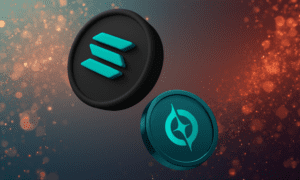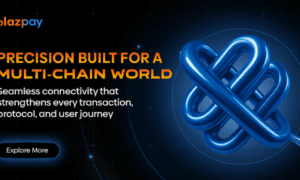The blockchain gaming industry is undergoing a profound transformation. Following the hype wave of 2021—when anything with the “crypto” label boomed overnight—came a sobering reality check. Gamers grew disillusioned with speculative models, while developers ran headfirst into the technological barriers hindering mainstream adoption.
Who Is Dmytro Poltavskyi? From Mobile Games to Blockchain Gaming Pioneer
Before becoming a technical lead at Upland—one of the most prominent projects at the intersection of gaming and blockchain—Dmytro Poltavskyi followed a classic engineering trajectory. A graduate of the Black Sea National University, he started his career in mobile game development, quickly climbing the ladder from junior developer to team lead.
His work on high-demand mobile applications, user experience optimization, and game engines laid a strong foundation. Eventually captivated by blockchain’s potential, Poltavskyi pivoted to cryptocurrency application development, becoming one of the pioneers rethinking how people interact with this emerging technology.
Today, he creates user experiences that make blockchain technology invisible to the average player while preserving its core benefits. His strategies for removing barriers and building sustainable game economies have led the industry to reconsider how blockchain should actually work in gaming.
At Uplandme Inc., Poltavskyi has been instrumental in developing Upland—a virtual world where players buy and develop digital real estate that mirrors actual locations in major cities worldwide. Think of it as a digital version of Monopoly, but where the properties correspond to real addresses in San Francisco, New York, Tokyo, and dozens of other cities.
As one of the project’s architects from its earliest days, Poltavskyi helped create something unique in the gaming world: a place where virtual property has genuine value and utility. Players don’t just collect digital items—they build businesses, host events, and collaborate with major brands like FIFA on virtual experiences.
The numbers tell the story of his impact: under Poltavskyi’s technical guidance, Upland has grown to over 3 million users who have collectively withdrawn more than $13.5 million in real earnings from their virtual activities. This success comes from solving problems that most blockchain games ignore—making the technology work seamlessly for everyday players.
“We’re building a digital world that actually works for regular people, not just crypto enthusiasts,” Poltavskyi explains.
From Speculation to Real Value: Creating Games People Actually Want to Play
“People are tired of games where the only point is making quick money,” Poltavskyi admits, recalling when most blockchain games were just thinly disguised get-rich-quick schemes. The market had become oversaturated with projects where playing felt more like a job than entertainment.
Analyzing these problems, Poltavskyi championed what he calls the “Play-to-Own” approach. In Upland, virtual assets are tied to real-world geography—players acquire digital plots, buildings, and collectibles mapped onto actual cities. The key difference: these assets are valuable because of what you can do with them in the game, not because you might sell them later.
Upland property owners can generate income through various activities—from hosting virtual exhibitions to participating in quests created by other players. It’s like owning rental property, but in a digital world that’s actually fun to explore.
The approach has proven successful: Upland regularly ranks among the top blockchain gaming apps and has attracted over 3 million registered players who see their virtual possessions as genuinely useful, not just speculative investments.
Removing the Biggest Barrier: Making Crypto Invisible
“The biggest problem for normal people is having to deal with cryptocurrency wallets and complex passwords,” says Poltavskyi, identifying what kills most people’s interest in blockchain games before they even start.
The traditional process is intimidating: install special software, write down a 12-word recovery phrase, buy cryptocurrency just to begin playing. Poltavskyi discovered that up to 80% of potential players gave up at this stage.
His solution was elegantly simple: make all the crypto stuff happen in the background. In Upland, starting requires only an email and password—just like Netflix or any other online service. The blockchain account gets created automatically later, once players understand and want the benefits.
The results were immediate: the number of people who quit right away dropped by nearly 50%, and 35% more players made their first purchase. By hiding the complexity, Poltavskyi opened blockchain gaming to millions of people who would never have tried it otherwise.
When Technology Gets in the Way: Solving the Speed Problem
As Upland grew more sophisticated—adding new cities and detailed 3D environments—Poltavskyi faced a classic tech problem: the game started running poorly on older phones.
“We could have just told people to buy newer phones,” Poltavskyi recalls, “but that would mean losing half our players.” Instead, he redesigned how the game displays graphics, creating systems that automatically adjust quality based on each device’s capabilities.
The solution was like having a smart TV that automatically switches to HD or 4K depending on your internet speed. Powerful phones see every detail, while older devices get a simplified but still attractive version. Performance improved dramatically—the game now runs three times smoother on average.
This technical work directly supported business goals: players stayed engaged regardless of their hardware, and Upland could expand without leaving anyone behind.
Building Stability in an Unstable World
Anyone following cryptocurrency knows its biggest problem: prices that swing wildly from day to day. Poltavskyi faced a puzzle: how do you build a stable game economy when the underlying technology is famous for instability?
His solution defied conventional crypto wisdom: Poltavskyi designed Upland’s currency to work like regular money. The game’s UPX currency is tied directly to the U.S. dollar and can only be purchased with traditional payment methods—no volatile cryptocurrencies required.
“We took the speculation out of everyday gameplay,” says Dmytro. Players know exactly what their investments are worth in real money, without worrying about crypto market crashes.
While some crypto purists weren’t convinced, players kept earning—and without the usual market rollercoaster.
Making Digital Collectibles Actually Useful
One of Poltavskyi’s most innovative contributions addresses a common frustration: people spend money on digital collectibles that just sit unused in storage. His team created a system that lets players import their digital items from other platforms and actually use them in Upland.
“Instead of digital trading cards collecting dust, players can display them in virtual galleries and earn money from visitors,” Dmytro explains. It transforms static collectibles into interactive, income-generating assets.
This changes how people think about digital ownership. When a collectible becomes part of gameplay rather than just an investment, it feels more like real property than a speculative asset.
Building Trust Through Results, Not Promises
In an industry full of grand promises and failed projects, Poltavskyi has built partnerships based on proven results rather than marketing hype.
“Real partnerships require working solutions, not just press releases,” he insists. When collaborating with other blockchain networks, Upland’s team focuses on extensive testing to ensure everything works before making announcements.
This approach has attracted partnerships with major brands including FIFA, UNICEF, and the NFL Players Association. These organizations trust Upland because it has demonstrated the ability to deliver reliable, professional experiences for their audiences.
Looking Ahead: When Blockchain Becomes Invisible
Poltavskyi predicts that blockchain technology will follow the same path as the internet itself: “In ten years, we won’t even mention blockchain in interviews—it’ll just be part of how things work, like internet protocols today.”
He believes the industry is shifting toward functionality over speculation. Players increasingly care about what their digital assets can do, not just their potential resale value. The future belongs to games that offer genuine entertainment while quietly using blockchain technology to enable true digital ownership.
From a technical standpoint, Poltavskyi expects improvements in speed and cost that will make blockchain transactions instant and nearly free, removing the last barriers to mainstream adoption.
Poltavskyi’s story demonstrates that the blockchain gaming revolution isn’t happening through buzzwords or hype—it’s being built through practical solutions to real problems. By focusing on user experience over technology evangelism, he has created something rare in the crypto world: a product that succeeds because it’s genuinely useful, not because it’s built on the latest trend.
The winners in this space will be projects that make advanced technology feel simple and natural, offering engaging experiences that happen to be powered by blockchain rather than defined by it.


































